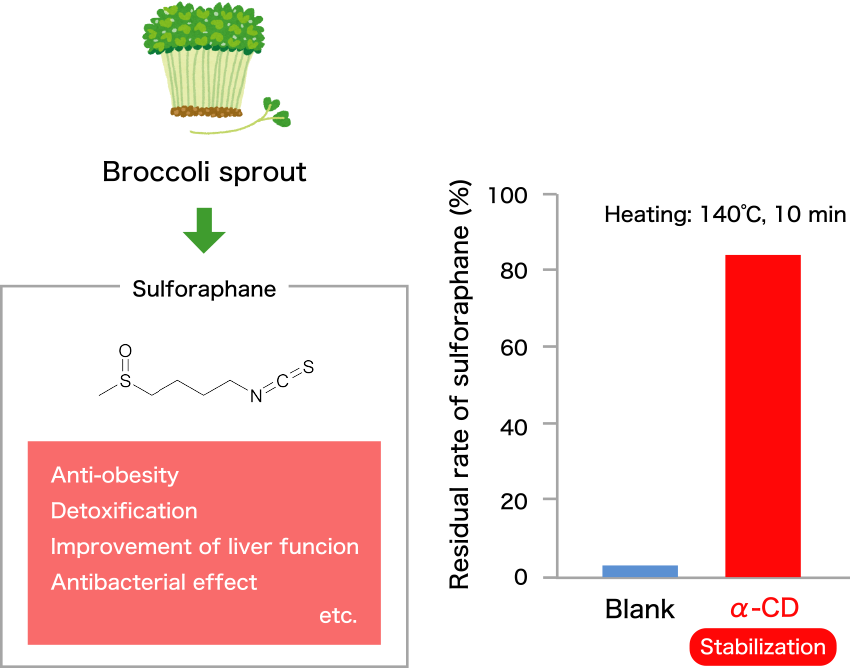No. 86 Stabilization of sulforaphane in broccoli sprout by α-cyclodextrin

Overview
Glucoraphanin present in broccoli sprouts (BS) is converted into sulforaphane (SFN) (Fig. 1) by an enzyme called myrosinase during mastication and crushing of BS. SFN is attracting attention as a functional ingredient that exhibits anti-obesity 1) and detoxification, but SFN is also a volatile and unstable compound. Regarding the stability of SFN, α-cyclodextrin (α-CD) has been shown to improve the stability of high-purity synthetic SFN 2), but detailed studies with BS extract have not been conducted. So far, we have conducted a storage stability test of BS extract using three types of natural CDs and reported that α-CD improves the stability of SFN 3).
In this study, BS powders using natural CDs and dextrin were prepared and the stability of SFN in the powders was evaluated.

Experiment
2-1. Preparation of BS powders using CD
Water was added to BS and the mixture was allowed to stand at 60℃ for 10 minutes. Dextrin, α-CD, β-CD, and γ-CD were added thereto, and mixed with a mixer, and the resulting pastes were freeze-dried to prepare powders.
2-2. Thermal stability test of SFN in BS powders using CD
BS powders were weighed into a test tube and heated to 140 ℃. After 0, 10, 30 and 60 minutes, SFN in the powders was extracted with ethyl acetate and quantified by HPLC. The residual rate of SFN was calculated with the value at 0 minutes as 100%.
Results and discussion
Under heating conditions at 140℃ for 10 minutes, almost no SFN remained in the powder of BS alone, and only 35% of SFN in the dextrin powder remained. On the other hand, the residual percentage of SFN was 53% in γ-CD powder, 80% in β-CD powder, and 84% in α-CD powder. Thus, the highest stability was shown when α-CD was used for the powder preparation (Fig. 2). Further, in the α-CD powder, the residual percentage of SFN was still high at 71% under the heating condition even after 60 minutes. Although SFN in BS powder without CDs volatilizes immediately when subjected to high-temperature heat treatment, it is considered that the volatilization of SFN could be suppressed by the stable complex formation with α-CD and the stability of SFN was improved.

Summary
This study revealed that the thermal stability of SFN in BS powder was improved by using α-CD. In addition, since intake of α-CD has various health-promoting effects*, it is thought that BS-α-CD powder is a very useful material in the development of new health foods.
*for further details, please refer to the "6th, 42th and 85th" research on our homepage.
References
1) Kyeong-Mi Choi et al., Journal of Nutritional Biochemistry, 25, 201–207 (2014).
2) Jed W. Fahey et al., Molecular Nutrition & Food Research, 61, 1600766 (2017).
3) M. Onishi, et al., 35th Cyclodextrin Symposium Abstracts, 162–163 (2018).
